Building Information Modelling (BIM) in Construction Design
VerifiedAdded on 2020/03/13
|11
|2732
|146
Report
AI Summary
This report delves into the application of Building Information Modelling (BIM) in construction system design, highlighting its transformative impact on the Architecture, Engineering, and Construction (AEC) industry. BIM, a technology-based process, enhances the efficiency and cost-effectiveness of construction projects throughout their lifecycle, from planning and design to construction and operation. The report explores the various purposes of BIM, including site analysis, cost estimation, phase planning, design review, engineering analysis, and sustainability assessments. It identifies the BIM software used, the necessary input information, and the resulting outputs and outcomes, such as 3D models, cost estimates, and performance simulations. Furthermore, the report underscores the human capabilities required for effective BIM implementation, such as software proficiency, analytical skills, and strong coordination abilities. By improving visualization, coordination, and collaboration, BIM is shown to reduce errors, minimize waste, and optimize building management, ultimately leading to more sustainable and efficient construction practices.
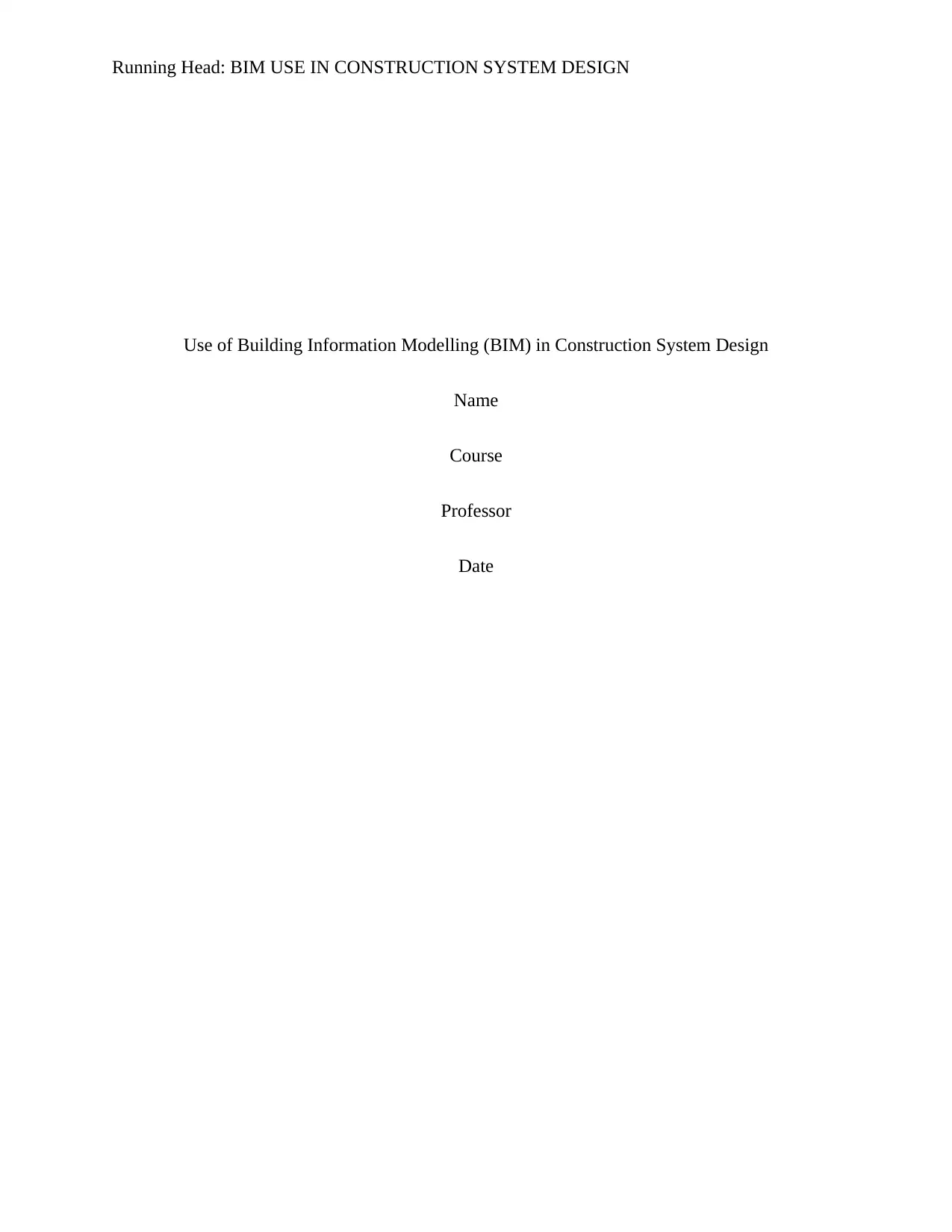
Running Head: BIM USE IN CONSTRUCTION SYSTEM DESIGN
Use of Building Information Modelling (BIM) in Construction System Design
Name
Course
Professor
Date
Use of Building Information Modelling (BIM) in Construction System Design
Name
Course
Professor
Date
Paraphrase This Document
Need a fresh take? Get an instant paraphrase of this document with our AI Paraphraser
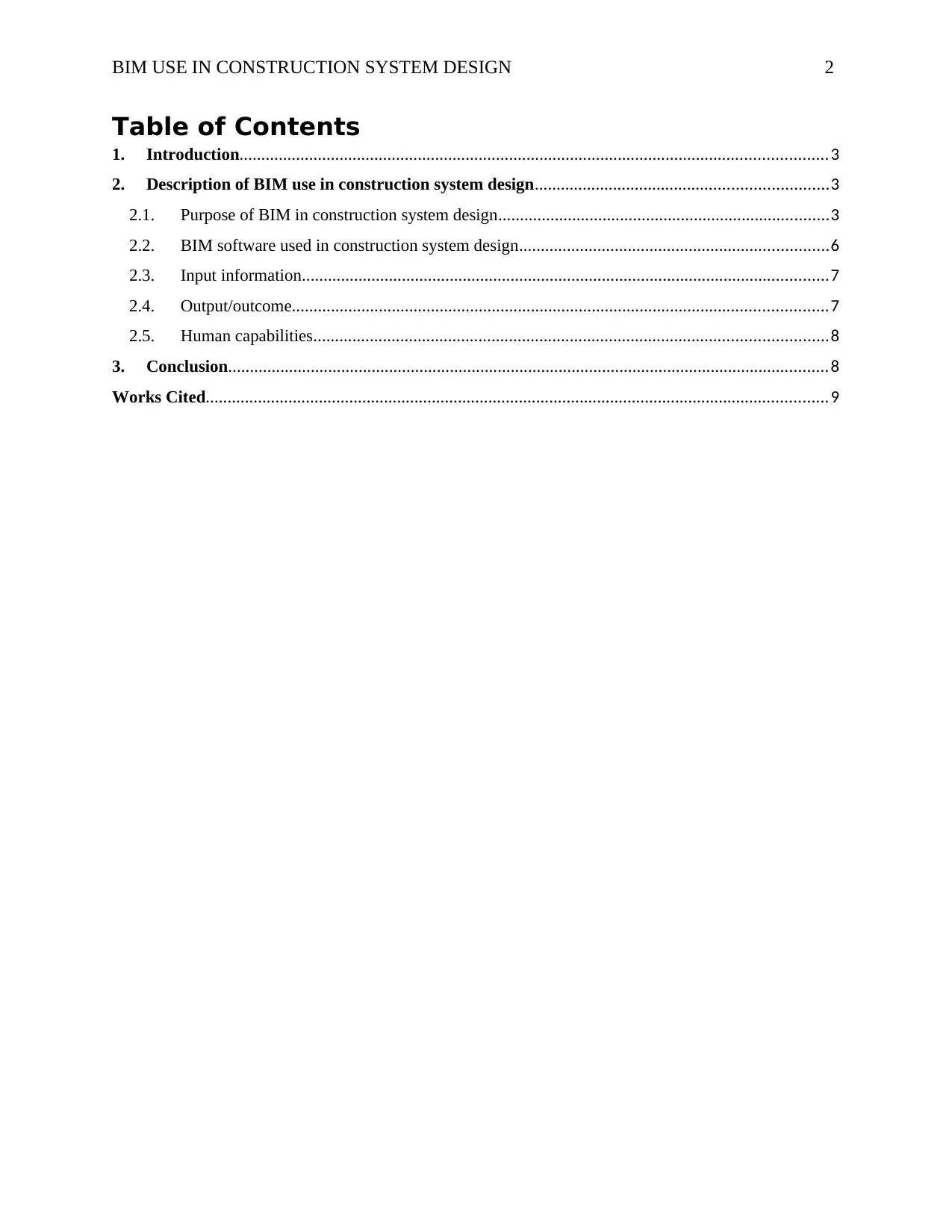
BIM USE IN CONSTRUCTION SYSTEM DESIGN 2
Table of Contents
1. Introduction.......................................................................................................................................3
2. Description of BIM use in construction system design...................................................................3
2.1. Purpose of BIM in construction system design............................................................................3
2.2. BIM software used in construction system design.......................................................................6
2.3. Input information.........................................................................................................................7
2.4. Output/outcome...........................................................................................................................7
2.5. Human capabilities......................................................................................................................8
3. Conclusion..........................................................................................................................................8
Works Cited...............................................................................................................................................9
Table of Contents
1. Introduction.......................................................................................................................................3
2. Description of BIM use in construction system design...................................................................3
2.1. Purpose of BIM in construction system design............................................................................3
2.2. BIM software used in construction system design.......................................................................6
2.3. Input information.........................................................................................................................7
2.4. Output/outcome...........................................................................................................................7
2.5. Human capabilities......................................................................................................................8
3. Conclusion..........................................................................................................................................8
Works Cited...............................................................................................................................................9
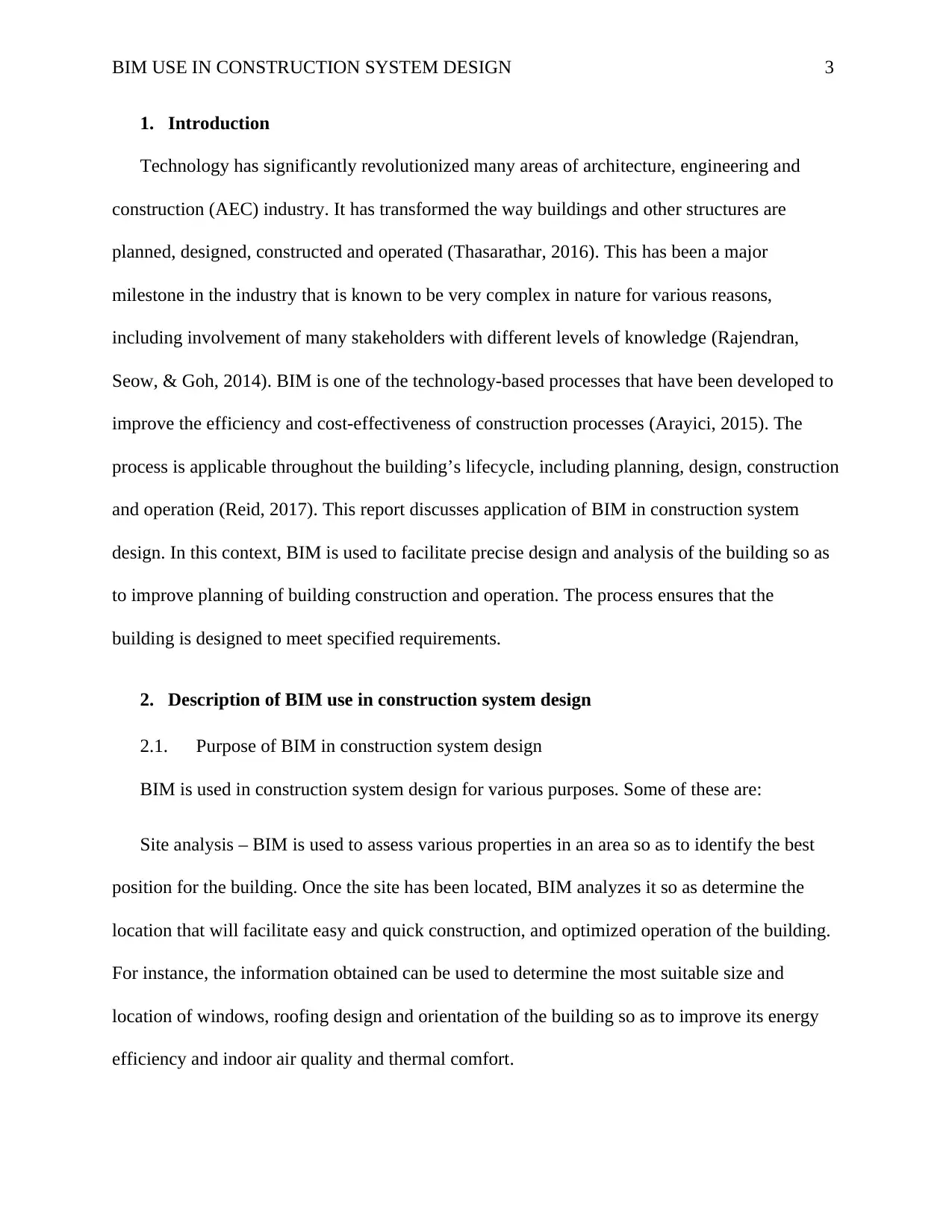
BIM USE IN CONSTRUCTION SYSTEM DESIGN 3
1. Introduction
Technology has significantly revolutionized many areas of architecture, engineering and
construction (AEC) industry. It has transformed the way buildings and other structures are
planned, designed, constructed and operated (Thasarathar, 2016). This has been a major
milestone in the industry that is known to be very complex in nature for various reasons,
including involvement of many stakeholders with different levels of knowledge (Rajendran,
Seow, & Goh, 2014). BIM is one of the technology-based processes that have been developed to
improve the efficiency and cost-effectiveness of construction processes (Arayici, 2015). The
process is applicable throughout the building’s lifecycle, including planning, design, construction
and operation (Reid, 2017). This report discusses application of BIM in construction system
design. In this context, BIM is used to facilitate precise design and analysis of the building so as
to improve planning of building construction and operation. The process ensures that the
building is designed to meet specified requirements.
2. Description of BIM use in construction system design
2.1. Purpose of BIM in construction system design
BIM is used in construction system design for various purposes. Some of these are:
Site analysis – BIM is used to assess various properties in an area so as to identify the best
position for the building. Once the site has been located, BIM analyzes it so as determine the
location that will facilitate easy and quick construction, and optimized operation of the building.
For instance, the information obtained can be used to determine the most suitable size and
location of windows, roofing design and orientation of the building so as to improve its energy
efficiency and indoor air quality and thermal comfort.
1. Introduction
Technology has significantly revolutionized many areas of architecture, engineering and
construction (AEC) industry. It has transformed the way buildings and other structures are
planned, designed, constructed and operated (Thasarathar, 2016). This has been a major
milestone in the industry that is known to be very complex in nature for various reasons,
including involvement of many stakeholders with different levels of knowledge (Rajendran,
Seow, & Goh, 2014). BIM is one of the technology-based processes that have been developed to
improve the efficiency and cost-effectiveness of construction processes (Arayici, 2015). The
process is applicable throughout the building’s lifecycle, including planning, design, construction
and operation (Reid, 2017). This report discusses application of BIM in construction system
design. In this context, BIM is used to facilitate precise design and analysis of the building so as
to improve planning of building construction and operation. The process ensures that the
building is designed to meet specified requirements.
2. Description of BIM use in construction system design
2.1. Purpose of BIM in construction system design
BIM is used in construction system design for various purposes. Some of these are:
Site analysis – BIM is used to assess various properties in an area so as to identify the best
position for the building. Once the site has been located, BIM analyzes it so as determine the
location that will facilitate easy and quick construction, and optimized operation of the building.
For instance, the information obtained can be used to determine the most suitable size and
location of windows, roofing design and orientation of the building so as to improve its energy
efficiency and indoor air quality and thermal comfort.
⊘ This is a preview!⊘
Do you want full access?
Subscribe today to unlock all pages.

Trusted by 1+ million students worldwide
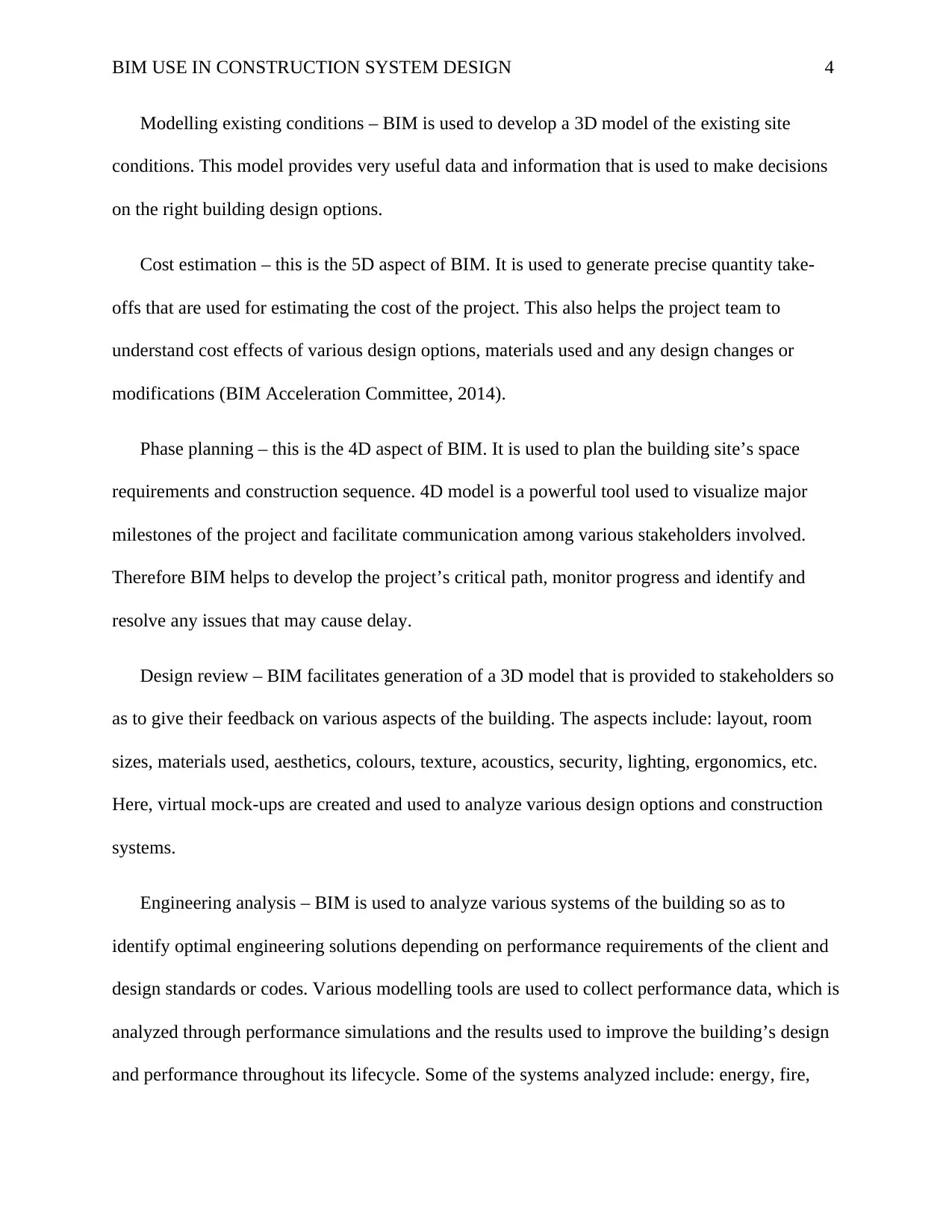
BIM USE IN CONSTRUCTION SYSTEM DESIGN 4
Modelling existing conditions – BIM is used to develop a 3D model of the existing site
conditions. This model provides very useful data and information that is used to make decisions
on the right building design options.
Cost estimation – this is the 5D aspect of BIM. It is used to generate precise quantity take-
offs that are used for estimating the cost of the project. This also helps the project team to
understand cost effects of various design options, materials used and any design changes or
modifications (BIM Acceleration Committee, 2014).
Phase planning – this is the 4D aspect of BIM. It is used to plan the building site’s space
requirements and construction sequence. 4D model is a powerful tool used to visualize major
milestones of the project and facilitate communication among various stakeholders involved.
Therefore BIM helps to develop the project’s critical path, monitor progress and identify and
resolve any issues that may cause delay.
Design review – BIM facilitates generation of a 3D model that is provided to stakeholders so
as to give their feedback on various aspects of the building. The aspects include: layout, room
sizes, materials used, aesthetics, colours, texture, acoustics, security, lighting, ergonomics, etc.
Here, virtual mock-ups are created and used to analyze various design options and construction
systems.
Engineering analysis – BIM is used to analyze various systems of the building so as to
identify optimal engineering solutions depending on performance requirements of the client and
design standards or codes. Various modelling tools are used to collect performance data, which is
analyzed through performance simulations and the results used to improve the building’s design
and performance throughout its lifecycle. Some of the systems analyzed include: energy, fire,
Modelling existing conditions – BIM is used to develop a 3D model of the existing site
conditions. This model provides very useful data and information that is used to make decisions
on the right building design options.
Cost estimation – this is the 5D aspect of BIM. It is used to generate precise quantity take-
offs that are used for estimating the cost of the project. This also helps the project team to
understand cost effects of various design options, materials used and any design changes or
modifications (BIM Acceleration Committee, 2014).
Phase planning – this is the 4D aspect of BIM. It is used to plan the building site’s space
requirements and construction sequence. 4D model is a powerful tool used to visualize major
milestones of the project and facilitate communication among various stakeholders involved.
Therefore BIM helps to develop the project’s critical path, monitor progress and identify and
resolve any issues that may cause delay.
Design review – BIM facilitates generation of a 3D model that is provided to stakeholders so
as to give their feedback on various aspects of the building. The aspects include: layout, room
sizes, materials used, aesthetics, colours, texture, acoustics, security, lighting, ergonomics, etc.
Here, virtual mock-ups are created and used to analyze various design options and construction
systems.
Engineering analysis – BIM is used to analyze various systems of the building so as to
identify optimal engineering solutions depending on performance requirements of the client and
design standards or codes. Various modelling tools are used to collect performance data, which is
analyzed through performance simulations and the results used to improve the building’s design
and performance throughout its lifecycle. Some of the systems analyzed include: energy, fire,
Paraphrase This Document
Need a fresh take? Get an instant paraphrase of this document with our AI Paraphraser
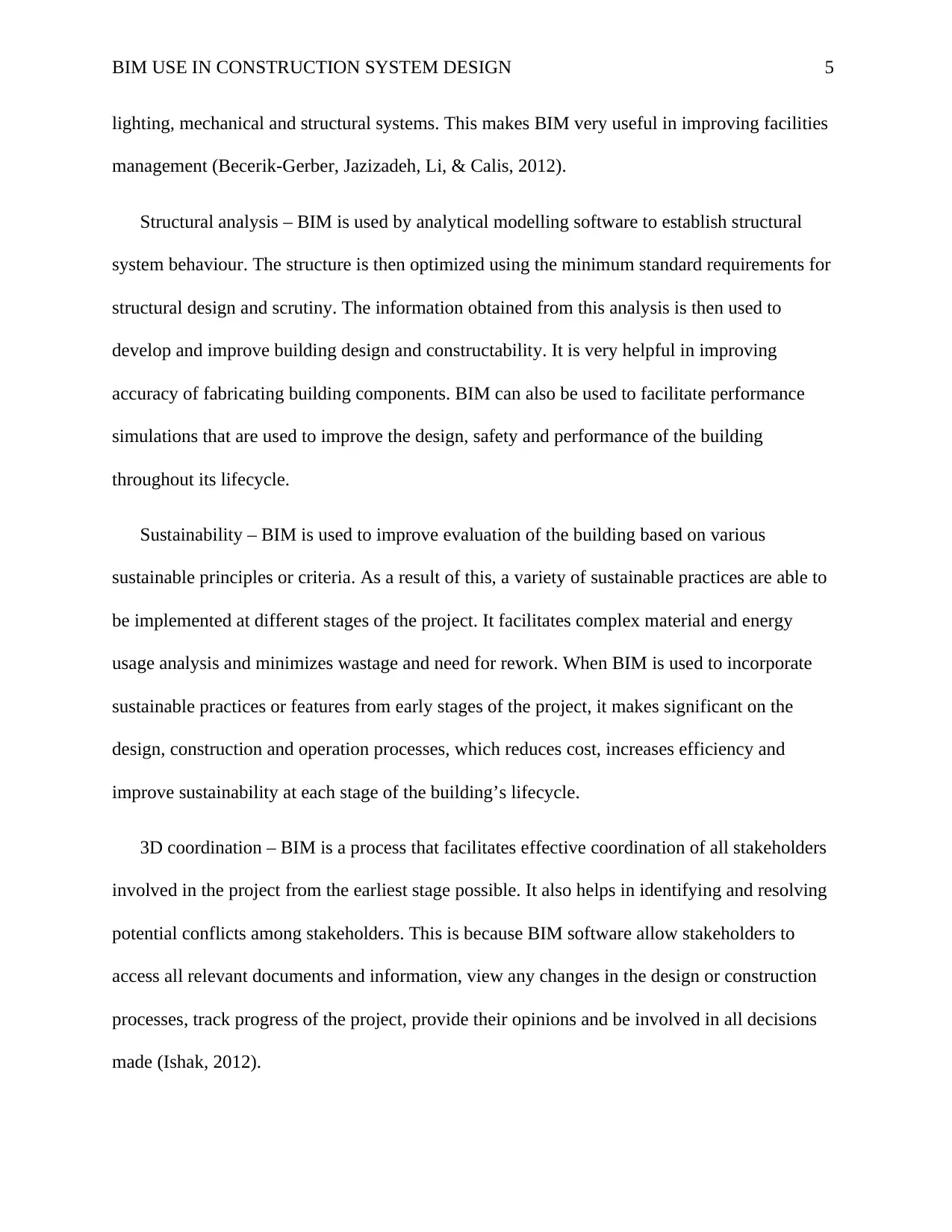
BIM USE IN CONSTRUCTION SYSTEM DESIGN 5
lighting, mechanical and structural systems. This makes BIM very useful in improving facilities
management (Becerik-Gerber, Jazizadeh, Li, & Calis, 2012).
Structural analysis – BIM is used by analytical modelling software to establish structural
system behaviour. The structure is then optimized using the minimum standard requirements for
structural design and scrutiny. The information obtained from this analysis is then used to
develop and improve building design and constructability. It is very helpful in improving
accuracy of fabricating building components. BIM can also be used to facilitate performance
simulations that are used to improve the design, safety and performance of the building
throughout its lifecycle.
Sustainability – BIM is used to improve evaluation of the building based on various
sustainable principles or criteria. As a result of this, a variety of sustainable practices are able to
be implemented at different stages of the project. It facilitates complex material and energy
usage analysis and minimizes wastage and need for rework. When BIM is used to incorporate
sustainable practices or features from early stages of the project, it makes significant on the
design, construction and operation processes, which reduces cost, increases efficiency and
improve sustainability at each stage of the building’s lifecycle.
3D coordination – BIM is a process that facilitates effective coordination of all stakeholders
involved in the project from the earliest stage possible. It also helps in identifying and resolving
potential conflicts among stakeholders. This is because BIM software allow stakeholders to
access all relevant documents and information, view any changes in the design or construction
processes, track progress of the project, provide their opinions and be involved in all decisions
made (Ishak, 2012).
lighting, mechanical and structural systems. This makes BIM very useful in improving facilities
management (Becerik-Gerber, Jazizadeh, Li, & Calis, 2012).
Structural analysis – BIM is used by analytical modelling software to establish structural
system behaviour. The structure is then optimized using the minimum standard requirements for
structural design and scrutiny. The information obtained from this analysis is then used to
develop and improve building design and constructability. It is very helpful in improving
accuracy of fabricating building components. BIM can also be used to facilitate performance
simulations that are used to improve the design, safety and performance of the building
throughout its lifecycle.
Sustainability – BIM is used to improve evaluation of the building based on various
sustainable principles or criteria. As a result of this, a variety of sustainable practices are able to
be implemented at different stages of the project. It facilitates complex material and energy
usage analysis and minimizes wastage and need for rework. When BIM is used to incorporate
sustainable practices or features from early stages of the project, it makes significant on the
design, construction and operation processes, which reduces cost, increases efficiency and
improve sustainability at each stage of the building’s lifecycle.
3D coordination – BIM is a process that facilitates effective coordination of all stakeholders
involved in the project from the earliest stage possible. It also helps in identifying and resolving
potential conflicts among stakeholders. This is because BIM software allow stakeholders to
access all relevant documents and information, view any changes in the design or construction
processes, track progress of the project, provide their opinions and be involved in all decisions
made (Ishak, 2012).
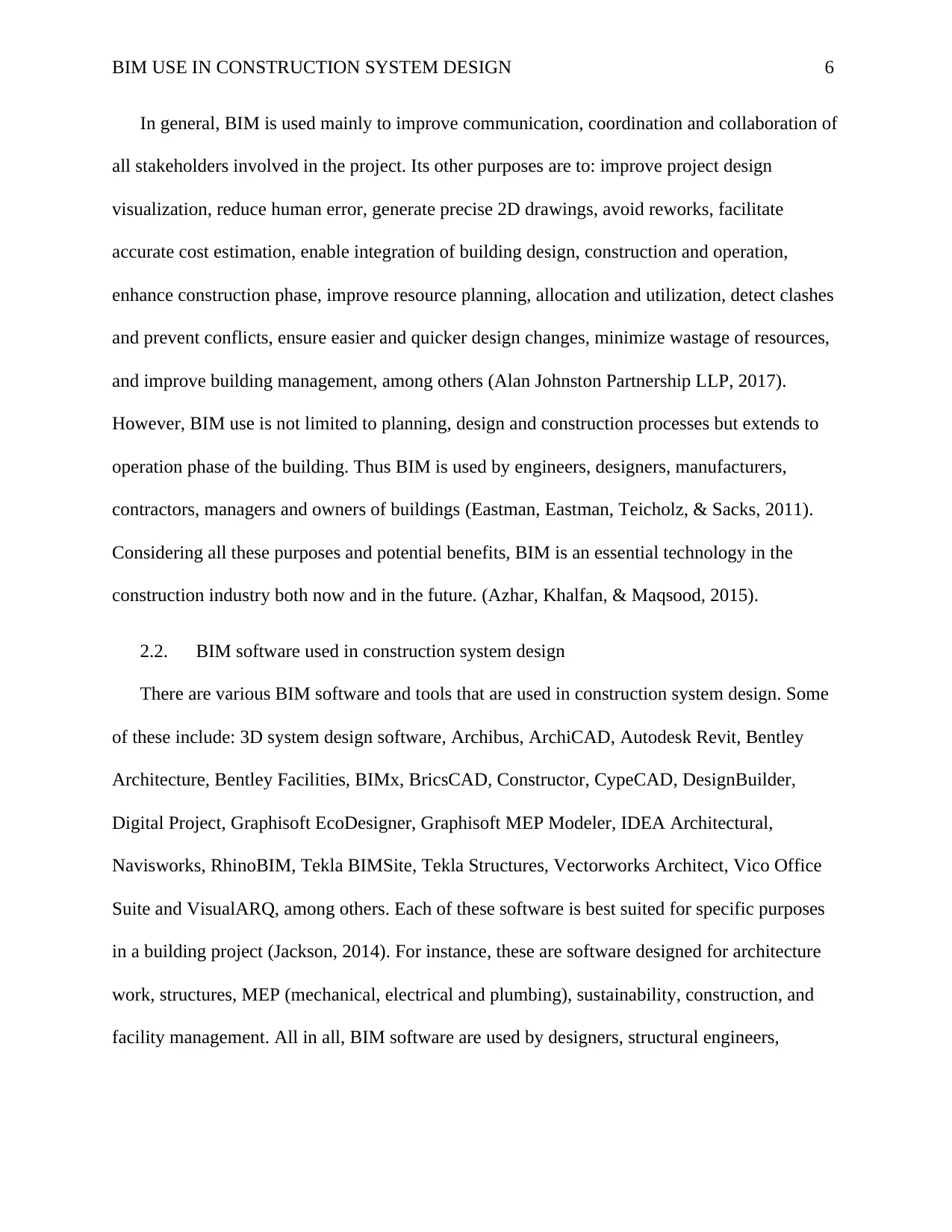
BIM USE IN CONSTRUCTION SYSTEM DESIGN 6
In general, BIM is used mainly to improve communication, coordination and collaboration of
all stakeholders involved in the project. Its other purposes are to: improve project design
visualization, reduce human error, generate precise 2D drawings, avoid reworks, facilitate
accurate cost estimation, enable integration of building design, construction and operation,
enhance construction phase, improve resource planning, allocation and utilization, detect clashes
and prevent conflicts, ensure easier and quicker design changes, minimize wastage of resources,
and improve building management, among others (Alan Johnston Partnership LLP, 2017).
However, BIM use is not limited to planning, design and construction processes but extends to
operation phase of the building. Thus BIM is used by engineers, designers, manufacturers,
contractors, managers and owners of buildings (Eastman, Eastman, Teicholz, & Sacks, 2011).
Considering all these purposes and potential benefits, BIM is an essential technology in the
construction industry both now and in the future. (Azhar, Khalfan, & Maqsood, 2015).
2.2. BIM software used in construction system design
There are various BIM software and tools that are used in construction system design. Some
of these include: 3D system design software, Archibus, ArchiCAD, Autodesk Revit, Bentley
Architecture, Bentley Facilities, BIMx, BricsCAD, Constructor, CypeCAD, DesignBuilder,
Digital Project, Graphisoft EcoDesigner, Graphisoft MEP Modeler, IDEA Architectural,
Navisworks, RhinoBIM, Tekla BIMSite, Tekla Structures, Vectorworks Architect, Vico Office
Suite and VisualARQ, among others. Each of these software is best suited for specific purposes
in a building project (Jackson, 2014). For instance, these are software designed for architecture
work, structures, MEP (mechanical, electrical and plumbing), sustainability, construction, and
facility management. All in all, BIM software are used by designers, structural engineers,
In general, BIM is used mainly to improve communication, coordination and collaboration of
all stakeholders involved in the project. Its other purposes are to: improve project design
visualization, reduce human error, generate precise 2D drawings, avoid reworks, facilitate
accurate cost estimation, enable integration of building design, construction and operation,
enhance construction phase, improve resource planning, allocation and utilization, detect clashes
and prevent conflicts, ensure easier and quicker design changes, minimize wastage of resources,
and improve building management, among others (Alan Johnston Partnership LLP, 2017).
However, BIM use is not limited to planning, design and construction processes but extends to
operation phase of the building. Thus BIM is used by engineers, designers, manufacturers,
contractors, managers and owners of buildings (Eastman, Eastman, Teicholz, & Sacks, 2011).
Considering all these purposes and potential benefits, BIM is an essential technology in the
construction industry both now and in the future. (Azhar, Khalfan, & Maqsood, 2015).
2.2. BIM software used in construction system design
There are various BIM software and tools that are used in construction system design. Some
of these include: 3D system design software, Archibus, ArchiCAD, Autodesk Revit, Bentley
Architecture, Bentley Facilities, BIMx, BricsCAD, Constructor, CypeCAD, DesignBuilder,
Digital Project, Graphisoft EcoDesigner, Graphisoft MEP Modeler, IDEA Architectural,
Navisworks, RhinoBIM, Tekla BIMSite, Tekla Structures, Vectorworks Architect, Vico Office
Suite and VisualARQ, among others. Each of these software is best suited for specific purposes
in a building project (Jackson, 2014). For instance, these are software designed for architecture
work, structures, MEP (mechanical, electrical and plumbing), sustainability, construction, and
facility management. All in all, BIM software are used by designers, structural engineers,
⊘ This is a preview!⊘
Do you want full access?
Subscribe today to unlock all pages.

Trusted by 1+ million students worldwide
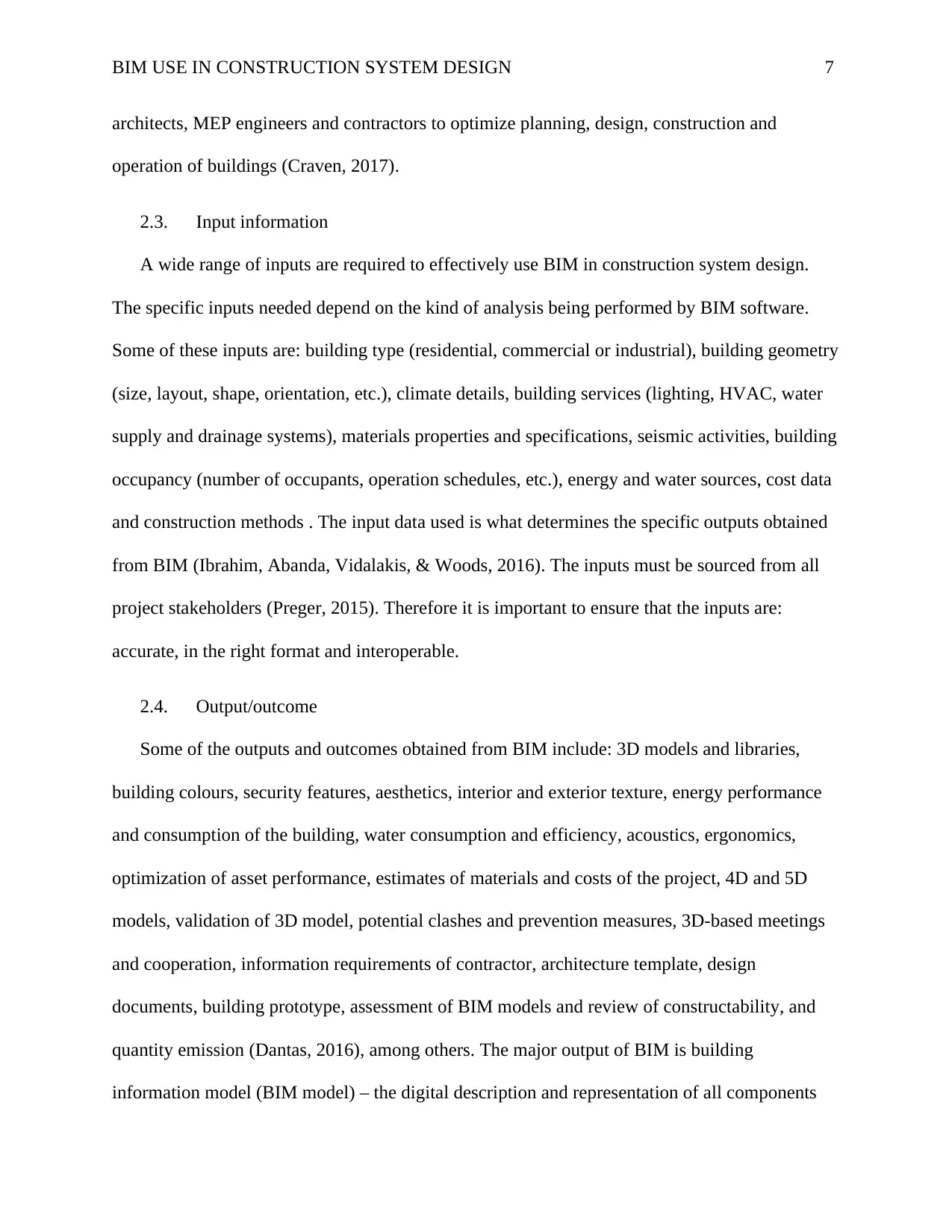
BIM USE IN CONSTRUCTION SYSTEM DESIGN 7
architects, MEP engineers and contractors to optimize planning, design, construction and
operation of buildings (Craven, 2017).
2.3. Input information
A wide range of inputs are required to effectively use BIM in construction system design.
The specific inputs needed depend on the kind of analysis being performed by BIM software.
Some of these inputs are: building type (residential, commercial or industrial), building geometry
(size, layout, shape, orientation, etc.), climate details, building services (lighting, HVAC, water
supply and drainage systems), materials properties and specifications, seismic activities, building
occupancy (number of occupants, operation schedules, etc.), energy and water sources, cost data
and construction methods . The input data used is what determines the specific outputs obtained
from BIM (Ibrahim, Abanda, Vidalakis, & Woods, 2016). The inputs must be sourced from all
project stakeholders (Preger, 2015). Therefore it is important to ensure that the inputs are:
accurate, in the right format and interoperable.
2.4. Output/outcome
Some of the outputs and outcomes obtained from BIM include: 3D models and libraries,
building colours, security features, aesthetics, interior and exterior texture, energy performance
and consumption of the building, water consumption and efficiency, acoustics, ergonomics,
optimization of asset performance, estimates of materials and costs of the project, 4D and 5D
models, validation of 3D model, potential clashes and prevention measures, 3D-based meetings
and cooperation, information requirements of contractor, architecture template, design
documents, building prototype, assessment of BIM models and review of constructability, and
quantity emission (Dantas, 2016), among others. The major output of BIM is building
information model (BIM model) – the digital description and representation of all components
architects, MEP engineers and contractors to optimize planning, design, construction and
operation of buildings (Craven, 2017).
2.3. Input information
A wide range of inputs are required to effectively use BIM in construction system design.
The specific inputs needed depend on the kind of analysis being performed by BIM software.
Some of these inputs are: building type (residential, commercial or industrial), building geometry
(size, layout, shape, orientation, etc.), climate details, building services (lighting, HVAC, water
supply and drainage systems), materials properties and specifications, seismic activities, building
occupancy (number of occupants, operation schedules, etc.), energy and water sources, cost data
and construction methods . The input data used is what determines the specific outputs obtained
from BIM (Ibrahim, Abanda, Vidalakis, & Woods, 2016). The inputs must be sourced from all
project stakeholders (Preger, 2015). Therefore it is important to ensure that the inputs are:
accurate, in the right format and interoperable.
2.4. Output/outcome
Some of the outputs and outcomes obtained from BIM include: 3D models and libraries,
building colours, security features, aesthetics, interior and exterior texture, energy performance
and consumption of the building, water consumption and efficiency, acoustics, ergonomics,
optimization of asset performance, estimates of materials and costs of the project, 4D and 5D
models, validation of 3D model, potential clashes and prevention measures, 3D-based meetings
and cooperation, information requirements of contractor, architecture template, design
documents, building prototype, assessment of BIM models and review of constructability, and
quantity emission (Dantas, 2016), among others. The major output of BIM is building
information model (BIM model) – the digital description and representation of all components
Paraphrase This Document
Need a fresh take? Get an instant paraphrase of this document with our AI Paraphraser
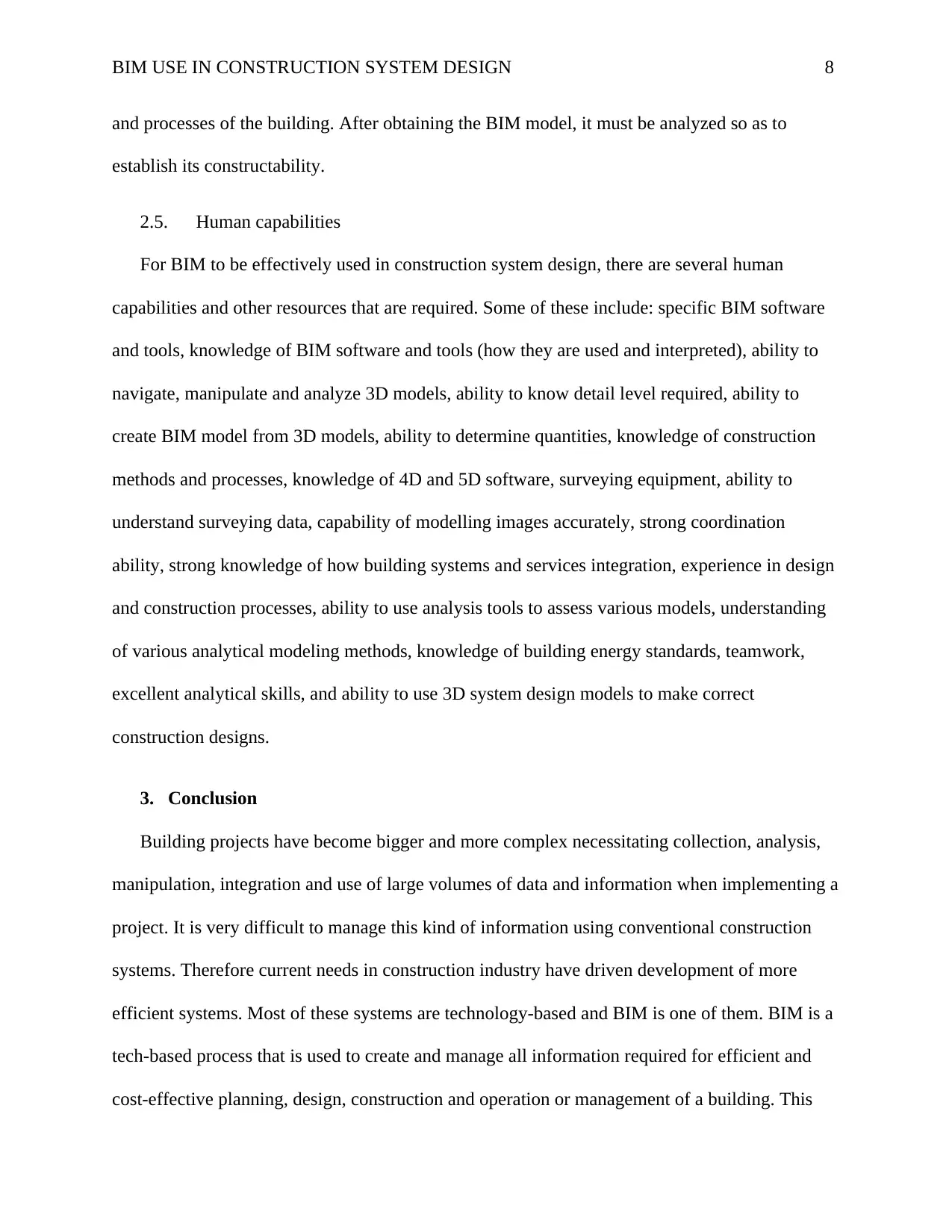
BIM USE IN CONSTRUCTION SYSTEM DESIGN 8
and processes of the building. After obtaining the BIM model, it must be analyzed so as to
establish its constructability.
2.5. Human capabilities
For BIM to be effectively used in construction system design, there are several human
capabilities and other resources that are required. Some of these include: specific BIM software
and tools, knowledge of BIM software and tools (how they are used and interpreted), ability to
navigate, manipulate and analyze 3D models, ability to know detail level required, ability to
create BIM model from 3D models, ability to determine quantities, knowledge of construction
methods and processes, knowledge of 4D and 5D software, surveying equipment, ability to
understand surveying data, capability of modelling images accurately, strong coordination
ability, strong knowledge of how building systems and services integration, experience in design
and construction processes, ability to use analysis tools to assess various models, understanding
of various analytical modeling methods, knowledge of building energy standards, teamwork,
excellent analytical skills, and ability to use 3D system design models to make correct
construction designs.
3. Conclusion
Building projects have become bigger and more complex necessitating collection, analysis,
manipulation, integration and use of large volumes of data and information when implementing a
project. It is very difficult to manage this kind of information using conventional construction
systems. Therefore current needs in construction industry have driven development of more
efficient systems. Most of these systems are technology-based and BIM is one of them. BIM is a
tech-based process that is used to create and manage all information required for efficient and
cost-effective planning, design, construction and operation or management of a building. This
and processes of the building. After obtaining the BIM model, it must be analyzed so as to
establish its constructability.
2.5. Human capabilities
For BIM to be effectively used in construction system design, there are several human
capabilities and other resources that are required. Some of these include: specific BIM software
and tools, knowledge of BIM software and tools (how they are used and interpreted), ability to
navigate, manipulate and analyze 3D models, ability to know detail level required, ability to
create BIM model from 3D models, ability to determine quantities, knowledge of construction
methods and processes, knowledge of 4D and 5D software, surveying equipment, ability to
understand surveying data, capability of modelling images accurately, strong coordination
ability, strong knowledge of how building systems and services integration, experience in design
and construction processes, ability to use analysis tools to assess various models, understanding
of various analytical modeling methods, knowledge of building energy standards, teamwork,
excellent analytical skills, and ability to use 3D system design models to make correct
construction designs.
3. Conclusion
Building projects have become bigger and more complex necessitating collection, analysis,
manipulation, integration and use of large volumes of data and information when implementing a
project. It is very difficult to manage this kind of information using conventional construction
systems. Therefore current needs in construction industry have driven development of more
efficient systems. Most of these systems are technology-based and BIM is one of them. BIM is a
tech-based process that is used to create and manage all information required for efficient and
cost-effective planning, design, construction and operation or management of a building. This
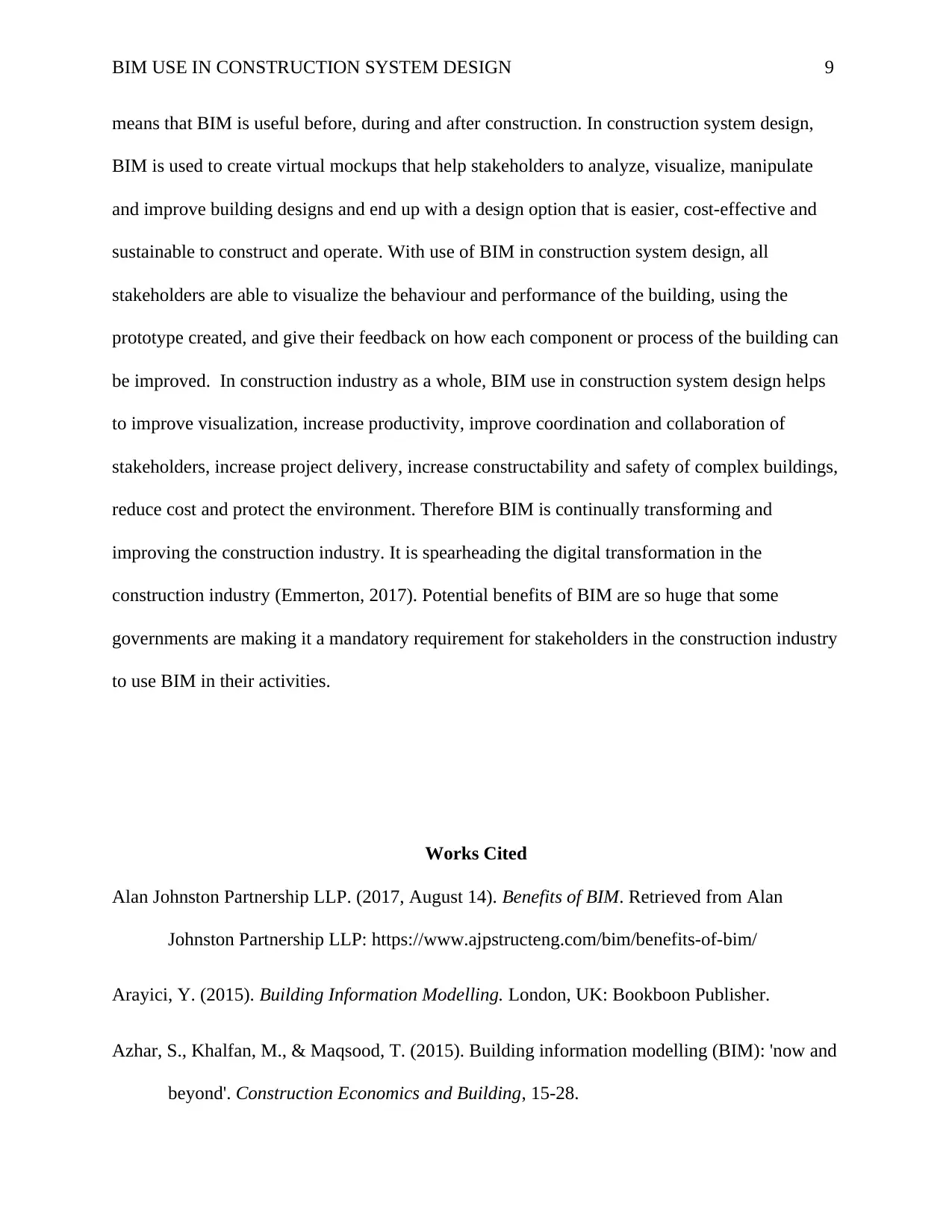
BIM USE IN CONSTRUCTION SYSTEM DESIGN 9
means that BIM is useful before, during and after construction. In construction system design,
BIM is used to create virtual mockups that help stakeholders to analyze, visualize, manipulate
and improve building designs and end up with a design option that is easier, cost-effective and
sustainable to construct and operate. With use of BIM in construction system design, all
stakeholders are able to visualize the behaviour and performance of the building, using the
prototype created, and give their feedback on how each component or process of the building can
be improved. In construction industry as a whole, BIM use in construction system design helps
to improve visualization, increase productivity, improve coordination and collaboration of
stakeholders, increase project delivery, increase constructability and safety of complex buildings,
reduce cost and protect the environment. Therefore BIM is continually transforming and
improving the construction industry. It is spearheading the digital transformation in the
construction industry (Emmerton, 2017). Potential benefits of BIM are so huge that some
governments are making it a mandatory requirement for stakeholders in the construction industry
to use BIM in their activities.
Works Cited
Alan Johnston Partnership LLP. (2017, August 14). Benefits of BIM. Retrieved from Alan
Johnston Partnership LLP: https://www.ajpstructeng.com/bim/benefits-of-bim/
Arayici, Y. (2015). Building Information Modelling. London, UK: Bookboon Publisher.
Azhar, S., Khalfan, M., & Maqsood, T. (2015). Building information modelling (BIM): 'now and
beyond'. Construction Economics and Building, 15-28.
means that BIM is useful before, during and after construction. In construction system design,
BIM is used to create virtual mockups that help stakeholders to analyze, visualize, manipulate
and improve building designs and end up with a design option that is easier, cost-effective and
sustainable to construct and operate. With use of BIM in construction system design, all
stakeholders are able to visualize the behaviour and performance of the building, using the
prototype created, and give their feedback on how each component or process of the building can
be improved. In construction industry as a whole, BIM use in construction system design helps
to improve visualization, increase productivity, improve coordination and collaboration of
stakeholders, increase project delivery, increase constructability and safety of complex buildings,
reduce cost and protect the environment. Therefore BIM is continually transforming and
improving the construction industry. It is spearheading the digital transformation in the
construction industry (Emmerton, 2017). Potential benefits of BIM are so huge that some
governments are making it a mandatory requirement for stakeholders in the construction industry
to use BIM in their activities.
Works Cited
Alan Johnston Partnership LLP. (2017, August 14). Benefits of BIM. Retrieved from Alan
Johnston Partnership LLP: https://www.ajpstructeng.com/bim/benefits-of-bim/
Arayici, Y. (2015). Building Information Modelling. London, UK: Bookboon Publisher.
Azhar, S., Khalfan, M., & Maqsood, T. (2015). Building information modelling (BIM): 'now and
beyond'. Construction Economics and Building, 15-28.
⊘ This is a preview!⊘
Do you want full access?
Subscribe today to unlock all pages.

Trusted by 1+ million students worldwide
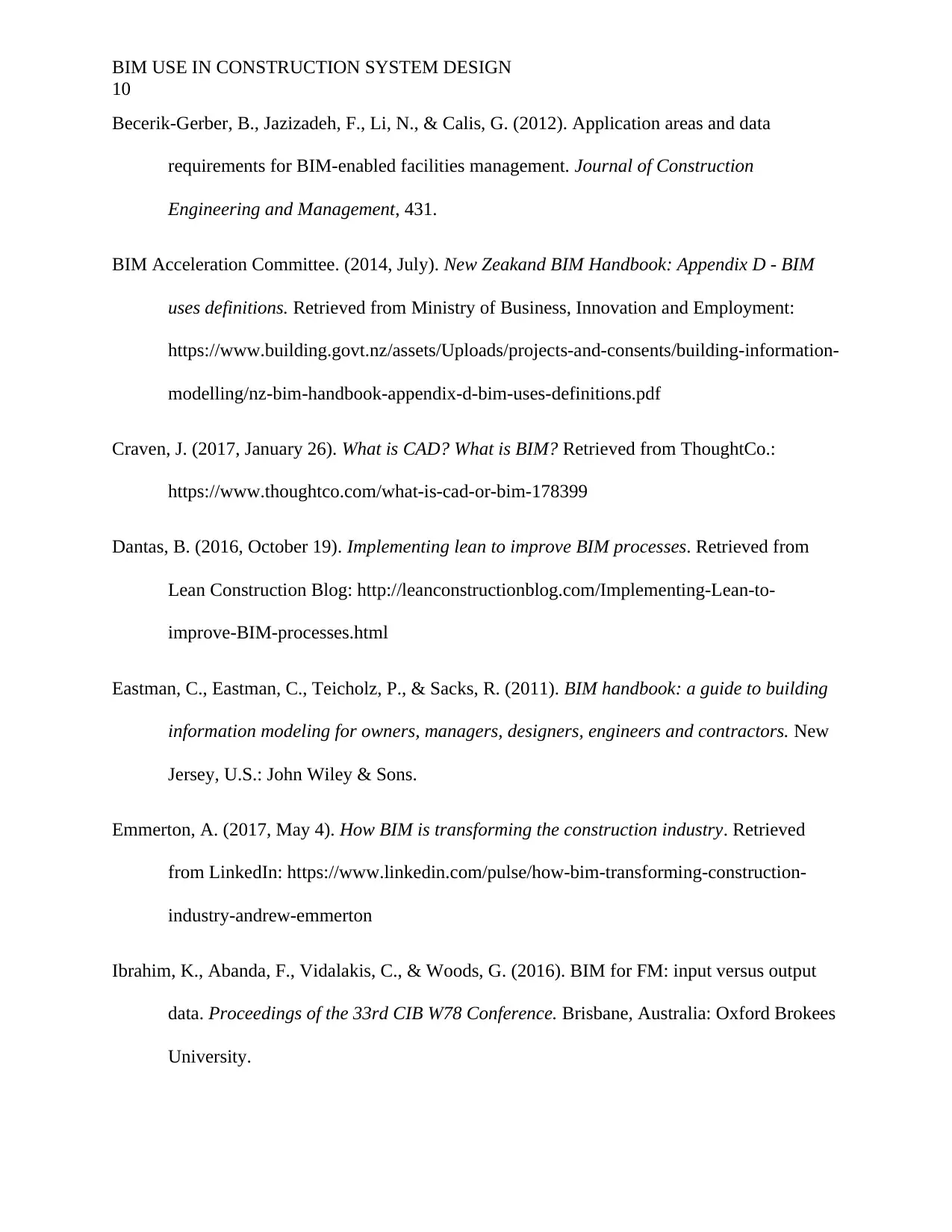
BIM USE IN CONSTRUCTION SYSTEM DESIGN
10
Becerik-Gerber, B., Jazizadeh, F., Li, N., & Calis, G. (2012). Application areas and data
requirements for BIM-enabled facilities management. Journal of Construction
Engineering and Management, 431.
BIM Acceleration Committee. (2014, July). New Zeakand BIM Handbook: Appendix D - BIM
uses definitions. Retrieved from Ministry of Business, Innovation and Employment:
https://www.building.govt.nz/assets/Uploads/projects-and-consents/building-information-
modelling/nz-bim-handbook-appendix-d-bim-uses-definitions.pdf
Craven, J. (2017, January 26). What is CAD? What is BIM? Retrieved from ThoughtCo.:
https://www.thoughtco.com/what-is-cad-or-bim-178399
Dantas, B. (2016, October 19). Implementing lean to improve BIM processes. Retrieved from
Lean Construction Blog: http://leanconstructionblog.com/Implementing-Lean-to-
improve-BIM-processes.html
Eastman, C., Eastman, C., Teicholz, P., & Sacks, R. (2011). BIM handbook: a guide to building
information modeling for owners, managers, designers, engineers and contractors. New
Jersey, U.S.: John Wiley & Sons.
Emmerton, A. (2017, May 4). How BIM is transforming the construction industry. Retrieved
from LinkedIn: https://www.linkedin.com/pulse/how-bim-transforming-construction-
industry-andrew-emmerton
Ibrahim, K., Abanda, F., Vidalakis, C., & Woods, G. (2016). BIM for FM: input versus output
data. Proceedings of the 33rd CIB W78 Conference. Brisbane, Australia: Oxford Brokees
University.
10
Becerik-Gerber, B., Jazizadeh, F., Li, N., & Calis, G. (2012). Application areas and data
requirements for BIM-enabled facilities management. Journal of Construction
Engineering and Management, 431.
BIM Acceleration Committee. (2014, July). New Zeakand BIM Handbook: Appendix D - BIM
uses definitions. Retrieved from Ministry of Business, Innovation and Employment:
https://www.building.govt.nz/assets/Uploads/projects-and-consents/building-information-
modelling/nz-bim-handbook-appendix-d-bim-uses-definitions.pdf
Craven, J. (2017, January 26). What is CAD? What is BIM? Retrieved from ThoughtCo.:
https://www.thoughtco.com/what-is-cad-or-bim-178399
Dantas, B. (2016, October 19). Implementing lean to improve BIM processes. Retrieved from
Lean Construction Blog: http://leanconstructionblog.com/Implementing-Lean-to-
improve-BIM-processes.html
Eastman, C., Eastman, C., Teicholz, P., & Sacks, R. (2011). BIM handbook: a guide to building
information modeling for owners, managers, designers, engineers and contractors. New
Jersey, U.S.: John Wiley & Sons.
Emmerton, A. (2017, May 4). How BIM is transforming the construction industry. Retrieved
from LinkedIn: https://www.linkedin.com/pulse/how-bim-transforming-construction-
industry-andrew-emmerton
Ibrahim, K., Abanda, F., Vidalakis, C., & Woods, G. (2016). BIM for FM: input versus output
data. Proceedings of the 33rd CIB W78 Conference. Brisbane, Australia: Oxford Brokees
University.
Paraphrase This Document
Need a fresh take? Get an instant paraphrase of this document with our AI Paraphraser
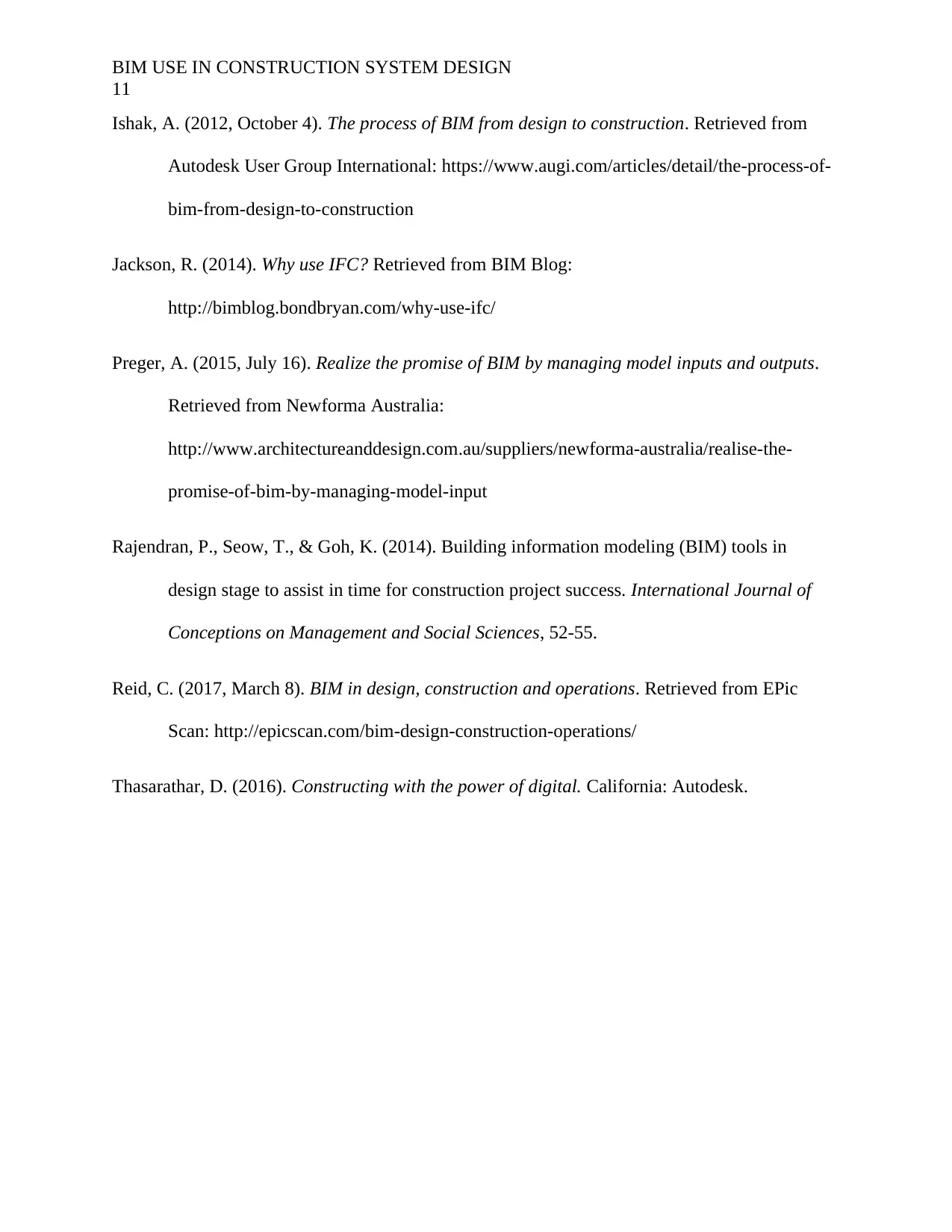
BIM USE IN CONSTRUCTION SYSTEM DESIGN
11
Ishak, A. (2012, October 4). The process of BIM from design to construction. Retrieved from
Autodesk User Group International: https://www.augi.com/articles/detail/the-process-of-
bim-from-design-to-construction
Jackson, R. (2014). Why use IFC? Retrieved from BIM Blog:
http://bimblog.bondbryan.com/why-use-ifc/
Preger, A. (2015, July 16). Realize the promise of BIM by managing model inputs and outputs.
Retrieved from Newforma Australia:
http://www.architectureanddesign.com.au/suppliers/newforma-australia/realise-the-
promise-of-bim-by-managing-model-input
Rajendran, P., Seow, T., & Goh, K. (2014). Building information modeling (BIM) tools in
design stage to assist in time for construction project success. International Journal of
Conceptions on Management and Social Sciences, 52-55.
Reid, C. (2017, March 8). BIM in design, construction and operations. Retrieved from EPic
Scan: http://epicscan.com/bim-design-construction-operations/
Thasarathar, D. (2016). Constructing with the power of digital. California: Autodesk.
11
Ishak, A. (2012, October 4). The process of BIM from design to construction. Retrieved from
Autodesk User Group International: https://www.augi.com/articles/detail/the-process-of-
bim-from-design-to-construction
Jackson, R. (2014). Why use IFC? Retrieved from BIM Blog:
http://bimblog.bondbryan.com/why-use-ifc/
Preger, A. (2015, July 16). Realize the promise of BIM by managing model inputs and outputs.
Retrieved from Newforma Australia:
http://www.architectureanddesign.com.au/suppliers/newforma-australia/realise-the-
promise-of-bim-by-managing-model-input
Rajendran, P., Seow, T., & Goh, K. (2014). Building information modeling (BIM) tools in
design stage to assist in time for construction project success. International Journal of
Conceptions on Management and Social Sciences, 52-55.
Reid, C. (2017, March 8). BIM in design, construction and operations. Retrieved from EPic
Scan: http://epicscan.com/bim-design-construction-operations/
Thasarathar, D. (2016). Constructing with the power of digital. California: Autodesk.
1 out of 11
Related Documents
Your All-in-One AI-Powered Toolkit for Academic Success.
+13062052269
info@desklib.com
Available 24*7 on WhatsApp / Email
![[object Object]](/_next/static/media/star-bottom.7253800d.svg)
Unlock your academic potential
Copyright © 2020–2025 A2Z Services. All Rights Reserved. Developed and managed by ZUCOL.





